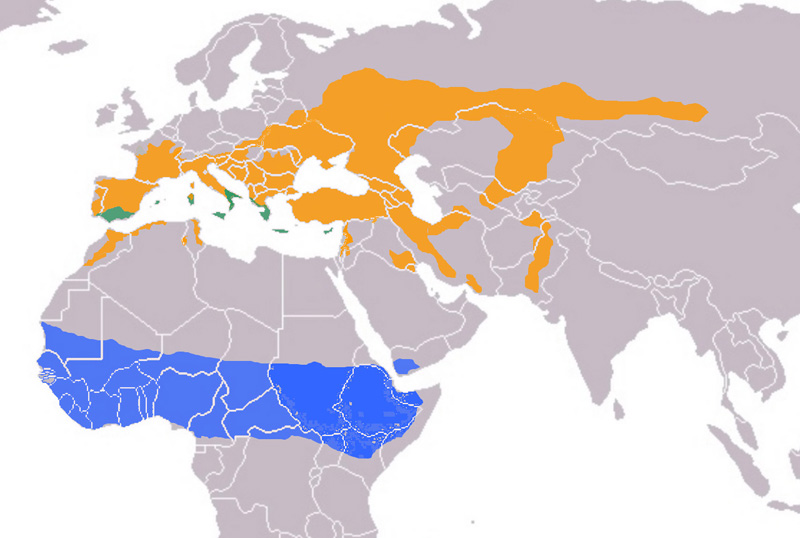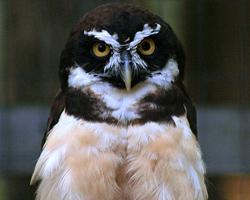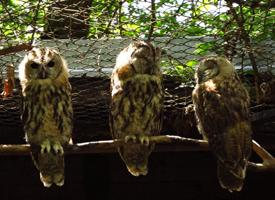
Súlyok és méretek
| Marmagasság | 19-tól 21-ig cm |
|---|---|
| Szárnyfesztávolság | 51-tól 63-ig cm |
Biológiai adatok
| Élettartam | 12 r |
|---|
Veszélyeztetettség
| Veszélyeztetett |
Állatleírás
The Eurasian scops owl (Otus scops), a captivating species within the Strigidae family, embodies the mystique and allure commonly associated with owls. This small yet enchanting bird of prey can be found scattered across a vast range that stretches from parts of Europe and North Africa to Asia, favoring warmer climates and typically migrating to sub-Saharan Africa during the winter months to escape the cold.One of the most distinctive features of the Eurasian scops owl is its size. Standing at a mere 19 to 21 centimeters in height and weighing between 60 to 135 grams, it is among the smaller species within the owl family. Despite its diminutive stature, it boasts a wingspan that can reach up to 54 centimeters, enabling it to glide silently through the night skies in search of prey.
The plumage of the Eurasian scops owl is a masterful display of camouflage, featuring a blend of gray, brown, and rust colors that mimic the textures and shades of tree bark. This natural disguise allows it to blend seamlessly into its surroundings, making it nearly invisible to both predators and prey. The owl's facial disc is less pronounced than in other owl species, but its large, expressive eyes and characteristic ear tufts, which can be raised or lowered depending on its mood or alertness level, give it a distinctive appearance.
Eurasian scops owls lead predominantly nocturnal lives, emerging at dusk to hunt. Their diet primarily consists of insects, such as moths and beetles, although they are also known to consume small rodents, lizards, and other tiny creatures. These owls are adept hunters, utilizing their exceptional hearing and silent flight to locate and swoop down on unsuspecting prey.
During the breeding season, which typically begins in late spring and extends into the early summer months, the Eurasian scops owl engages in a fascinating courtship display. The male performs a series of melodic calls, a simple yet haunting "puu-puu-puu" sound that can be heard echoing through the night. These calls serve to attract females and also to mark the male's territory. Nests are usually located in tree cavities, abandoned woodpecker holes, or even in crevices of buildings, reflecting the owl's adaptability to various environments.
The female lays between 3 to 6 eggs, which she incubates for about 20 to 25 days. During this period, the male provides food for the female and, later, for their chicks. The young owlets grow rapidly, fledging approximately a month after hatching, though they continue to rely on their parents for food and protection for several weeks thereafter.
The Eurasian scops owl plays a significant role in its ecosystem, acting as both predator and prey. Its presence helps control insect populations, while the owl itself falls prey to larger birds of prey. Despite facing threats from habitat destruction and pollution, the Eurasian scops owl remains widespread and is listed as Least Concern by the International Union for Conservation of Nature (IUCN), indicating a stable population across its vast range.
In summary, the Eurasian scops owl is a small, elusive bird of prey with a wide range and a remarkable ability to blend into its environment. Its life cycle, from the solitary, nocturnal hunt to the communal effort of raising young, showcases the adaptability and resilience of this fascinating species.
Előfordulási térkép

Hasonló állatok
Új állatfotók
Top 10 állat
- Dolphin gull (Leucophaeus scoresbii)
- Japanese macaque (Macaca fuscata)
- Stone loach (Barbatula barbatula)
- Russian tortoise (Testudo horsfieldii)
- Galápagos tortoise (Geochelone nigra complex)
- Greek tortoise (Testudo graeca)
- Diana monkey (Cercopithecus diana)
- Common flying dragon (Draco volans)
- Moustached guenon (Cercopithecus cephus)
- Galápagos penguin (Spheniscus mendiculus)


